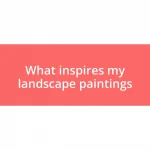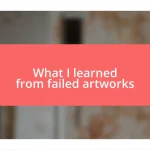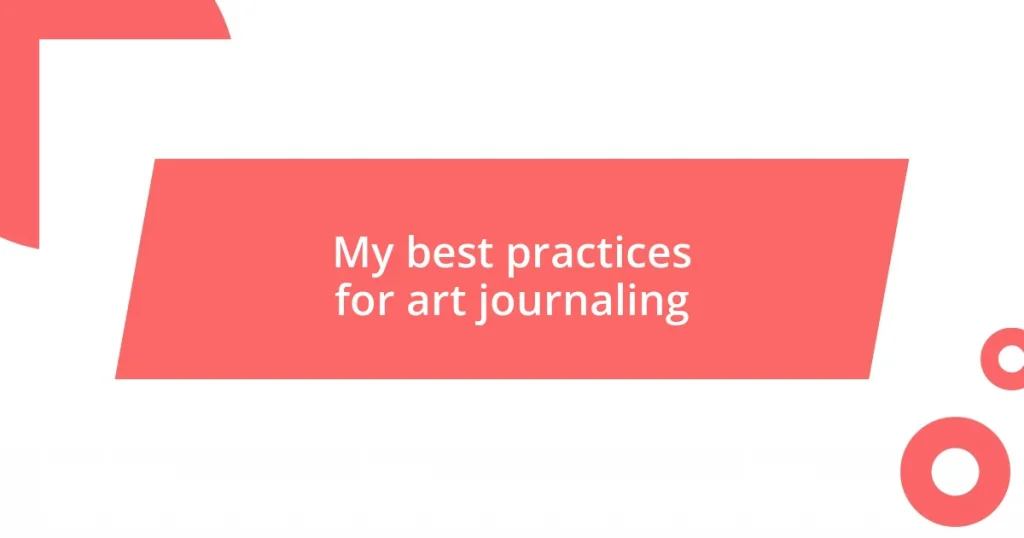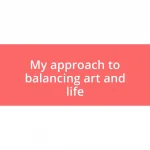Key takeaways:
- Art journaling blends creativity and self-expression, allowing individuals to explore emotions through imagery and text without strict rules.
- Choosing the right supplies enhances the journaling experience, with focus on quality materials like watercolor paints and mixed-media journals for experimentation.
- Establishing a regular journaling routine and sharing creative journeys with others fosters community, encourages personal growth, and helps overcome creative blocks.

Understanding Art Journaling Basics
Art journaling is a beautiful blend of creativity and self-expression, where the page becomes a personal canvas for your thoughts, feelings, and artistic explorations. I remember the first time I let my emotions spill onto a page; it felt liberating, almost like a weight had been lifted. Have you ever felt the urge to express something but struggled to find the words? That’s where art journaling can step in, allowing you to combine imagery and text to convey what’s in your heart.
What I love about art journaling is its flexibility—there are no strict rules. You can doodle, paint, collage, or just write; it all depends on what resonates with you. I once spent an entire afternoon layering colors and textures on a page, and the process itself transformed my mood. Isn’t it fascinating how the act of creating can be so healing and restorative?
To get started, you don’t need fancy supplies—just a journal and some basic art materials. Reflecting on my own journey, starting small made all the difference. Each mark I made on the page felt like a step towards understanding myself better. Have you considered what your first entry might look like? It’s all about embracing the moment and letting go of perfection; after all, the joy is in the journey, not the outcome.

Choosing the Right Supplies
Choosing the right supplies for art journaling can truly enhance your experience. I remember stepping into an art store, overwhelmed by the selection. Each product seemed to call out to me, but I learned not to get swayed by trendy items. I discovered that my favorites quickly became a handful of reliable gel pens, some quality watercolor paints, and a good sketchbook. Have you thought about what feels best in your hands while you create?
When selecting supplies, consider the type of medium you enjoy using. For instance, if you love vibrant colors, high-quality watercolors or acrylic paints can transform your pages. I once opted for cheaper paints, but they didn’t provide the same rich saturation I craved. In contrast, investing in a couple of good paintbrushes made my art feel more polished and enjoyable.
Additionally, think about the texture of your journal. Some pages can’t handle wet media, leading to frustration. I learned that a mixed-media journal not only invites experimentation, but each page feels like an open invitation to play. Which textures excite your creativity? With the right supplies, you can embark on this journey with confidence.
| Supply Type | Importance |
|---|---|
| Watercolor Paints | Versatile for vibrant designs |
| Quality Sketchbook | Supports various media without bleed-through |
| Gel Pens | Great for fine details and writing |
| Acrylic Paints | Bold colors with quick drying |

Establishing a Routine for Journaling
Establishing a routine for art journaling can transform your creative practice into a meaningful ritual. I’ve found that setting aside a regular time each week not only helps me to stay committed but also gives my creativity the space to flourish. For instance, when I began dedicating Sunday mornings to my journaling, it felt like flipping a switch; suddenly, I was more excited and driven to explore my thoughts and emotions on the page.
- Choose a specific day or time that works for you.
- Start with just 15 minutes, slowly increasing as you feel more comfortable.
- Find a cozy and inspiring space, whether it’s a corner in your home or your favorite park.
- Use prompts or themes to guide your sessions and keep things fresh.
- Set reminders on your phone or calendar to build consistency.
By prioritizing this creative outlet, I’ve noticed that the act of journaling becomes a sanctuary, allowing me to unwind and reconnect with myself. Have you thought about how establishing a routine might enhance your experience? Each time I sit down to create, it’s like reuniting with an old friend, and I always leave feeling nourished and inspired.

Techniques for Creative Expression
When I think about techniques for creative expression, layering is one practice that stands out to me. It allows you to build depth and engage with your emotions in unique ways. I often start with a background wash of color, letting it dry before adding sketches or collage elements on top. This approach not only enhances visual interest but also transforms a blank page into a story waiting to unfold. Have you ever layered different mediums to see what emerges?
Another technique that I cherish is the use of found objects. I’ve often found myself collecting bits of nature, like leaves or flowers, or even scraps of packaging that resonate with me. These elements can add a personal touch to my journal. I vividly remember adding a pressed flower from a hike, which perfectly encapsulated that day’s joy. Incorporating personal keepsakes makes the experience more enriching, don’t you think? It creates connections that go beyond mere visuals.
Finally, I can’t stress enough the power of mixed media. Combining techniques—from stamping with everyday objects to splattering paint—can unleash unexpected creativity. I once grabbed a kitchen sponge and dipped it in paint, creating delightful patterns that brought an entirely new feel to my journal. Exploring different techniques keeps my practice fresh and exciting. What techniques are you eager to try? Embrace that curiosity, and let it guide your expressive journey!

Incorporating Mixed Media Elements
Incorporating mixed media elements into my art journal has been a game-changer in how I express myself. For instance, one afternoon, I stumbled upon an old magazine and couldn’t resist tearing out some vibrant pages to create a collage. The juxtaposition of different colors and textures sparked an unexpected joy in my work, making me wonder—have you explored the magic that happens when you blend various mediums?
One of my favorite techniques involves integrating textiles into my journal. I once added a scrap of fabric from a beloved t-shirt, stitching it into a page. This simple act filled my journal with a sense of nostalgia, transforming the piece into a tangible reminder of a cherished memory. Have you thought about how incorporating fabrics could lend your personal stories even more depth?
Lastly, I’ve enjoyed experimenting with unconventional tools. One project had me using a potato to stamp shapes and patterns, which added a playful element to my pages. That experience taught me that the possibilities are endless when I let go of traditional methods. Isn’t it exciting to think about what everyday items could add to your creative expression? Give it a try; you might just discover a new favorite technique!

Overcoming Creative Blocks
Creative blocks can feel overwhelming, but I’ve learned to navigate them with a few simple strategies. For instance, when I’m staring at a blank page and inspiration refuses to budge, I grab a book or a piece of art that resonates with me. I then take a moment to doodle or sketch inspired by that piece. I never fail to find that this sparks new ideas. Have you ever tried letting something outside yourself ignite that creative flame?
Another effective approach is to change my environment. I recall a time when I felt stuck after working in the same spot for days. So, I packed my journal and headed to a local park. The fresh air, vibrant colors of nature, and sounds of life around me awakened my senses and opened up new creative avenues. It made me realize how just a slight shift in surroundings can unlock pent-up creativity. What’s your favorite place to escape when you need a boost?
I’ve also found that sometimes, tackling a simple art prompt can help break through blocks. On more than one occasion, I’ve given myself a challenge, like drawing only with one color or creating a piece based on a particular word or feeling. I once dedicated a whole session to “curiosity,” and what emerged amazed me! Restrictions often breed creativity, don’t you think? Creating without the pressure to produce a masterpiece helps me reconnect with the joy of making.

Sharing Your Art Journal Journey
Sharing my art journal journey has been one of the most uplifting experiences I’ve had. I remember the first time I posted a page on social media; my heart raced. I anxiously wondered how people would react. To my surprise, the supportive comments from fellow artists encouraged me to keep sharing. It’s incredible how connecting with others can validate your creative expression, isn’t it?
One memorable moment happened during an art swap with a group of friends. We each sent a page from our journals to the next person, along with a note about our artistic process. When I received their pages, I found inspiration in their diverse styles and stories. It felt like we were sharing a piece of our souls, don’t you think? This exchange taught me that sharing isn’t just about showing off; it’s about building a community where creativity can flourish.
I’ve also started a small blog to document my art journal process. At first, I felt exposed, sharing not just finished pieces but also my fears and struggles. But the feedback from readers was profoundly motivating. They shared their own stories and insights, creating a dialogue that enriched both our journeys. Have you ever considered how sharing your vulnerabilities could open up such meaningful connections? It’s a reminder that art journals tell our personal stories, and sharing them can amplify their impact—transforming solitary moments into shared experiences.















